Understanding the Architecture of a 2G GSM Network
VerifiedAdded on 2019/09/30
|7
|2201
|386
Essay
AI Summary
The article discusses the 2G network, which uses different technologies such as GSM (Global System for Mobile Communication), IDEN (Integrated Digital Enhanced Network) and PDC (Personal Digital Cellular). TDMA is a technology used in 2G networks, which divides the narrow band into three time slots to raise its capacity. CDMA (Code Division Multiple Access) is another technology used in 2G networks, which allows multiple transmitters to send information simultaneously over a single channel. The article also explains the working of a 2G network, highlighting the four main areas: Network and Switching Subsystem (NSS), Base Station Subsystem (BSS), Mobile Station, and Operation and Support Subsystem.
Contribute Materials
Your contribution can guide someone’s learning journey. Share your
documents today.

Running head: Blog writing
Secure Best Marks with AI Grader
Need help grading? Try our AI Grader for instant feedback on your assignments.
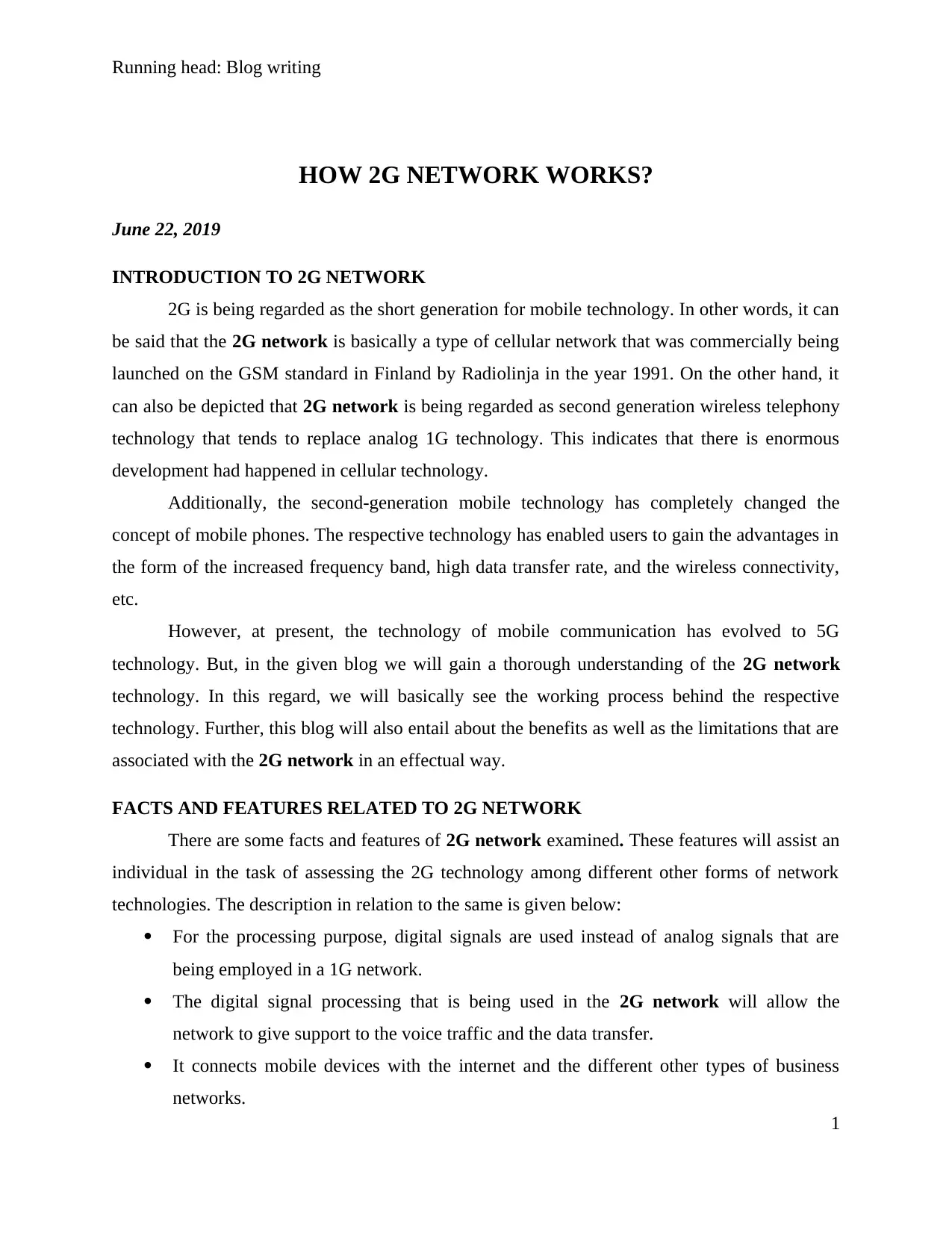
Running head: Blog writing
HOW 2G NETWORK WORKS?
June 22, 2019
INTRODUCTION TO 2G NETWORK
2G is being regarded as the short generation for mobile technology. In other words, it can
be said that the 2G network is basically a type of cellular network that was commercially being
launched on the GSM standard in Finland by Radiolinja in the year 1991. On the other hand, it
can also be depicted that 2G network is being regarded as second generation wireless telephony
technology that tends to replace analog 1G technology. This indicates that there is enormous
development had happened in cellular technology.
Additionally, the second-generation mobile technology has completely changed the
concept of mobile phones. The respective technology has enabled users to gain the advantages in
the form of the increased frequency band, high data transfer rate, and the wireless connectivity,
etc.
However, at present, the technology of mobile communication has evolved to 5G
technology. But, in the given blog we will gain a thorough understanding of the 2G network
technology. In this regard, we will basically see the working process behind the respective
technology. Further, this blog will also entail about the benefits as well as the limitations that are
associated with the 2G network in an effectual way.
FACTS AND FEATURES RELATED TO 2G NETWORK
There are some facts and features of 2G network examined. These features will assist an
individual in the task of assessing the 2G technology among different other forms of network
technologies. The description in relation to the same is given below:
For the processing purpose, digital signals are used instead of analog signals that are
being employed in a 1G network.
The digital signal processing that is being used in the 2G network will allow the
network to give support to the voice traffic and the data transfer.
It connects mobile devices with the internet and the different other types of business
networks.
1
HOW 2G NETWORK WORKS?
June 22, 2019
INTRODUCTION TO 2G NETWORK
2G is being regarded as the short generation for mobile technology. In other words, it can
be said that the 2G network is basically a type of cellular network that was commercially being
launched on the GSM standard in Finland by Radiolinja in the year 1991. On the other hand, it
can also be depicted that 2G network is being regarded as second generation wireless telephony
technology that tends to replace analog 1G technology. This indicates that there is enormous
development had happened in cellular technology.
Additionally, the second-generation mobile technology has completely changed the
concept of mobile phones. The respective technology has enabled users to gain the advantages in
the form of the increased frequency band, high data transfer rate, and the wireless connectivity,
etc.
However, at present, the technology of mobile communication has evolved to 5G
technology. But, in the given blog we will gain a thorough understanding of the 2G network
technology. In this regard, we will basically see the working process behind the respective
technology. Further, this blog will also entail about the benefits as well as the limitations that are
associated with the 2G network in an effectual way.
FACTS AND FEATURES RELATED TO 2G NETWORK
There are some facts and features of 2G network examined. These features will assist an
individual in the task of assessing the 2G technology among different other forms of network
technologies. The description in relation to the same is given below:
For the processing purpose, digital signals are used instead of analog signals that are
being employed in a 1G network.
The digital signal processing that is being used in the 2G network will allow the
network to give support to the voice traffic and the data transfer.
It connects mobile devices with the internet and the different other types of business
networks.
1
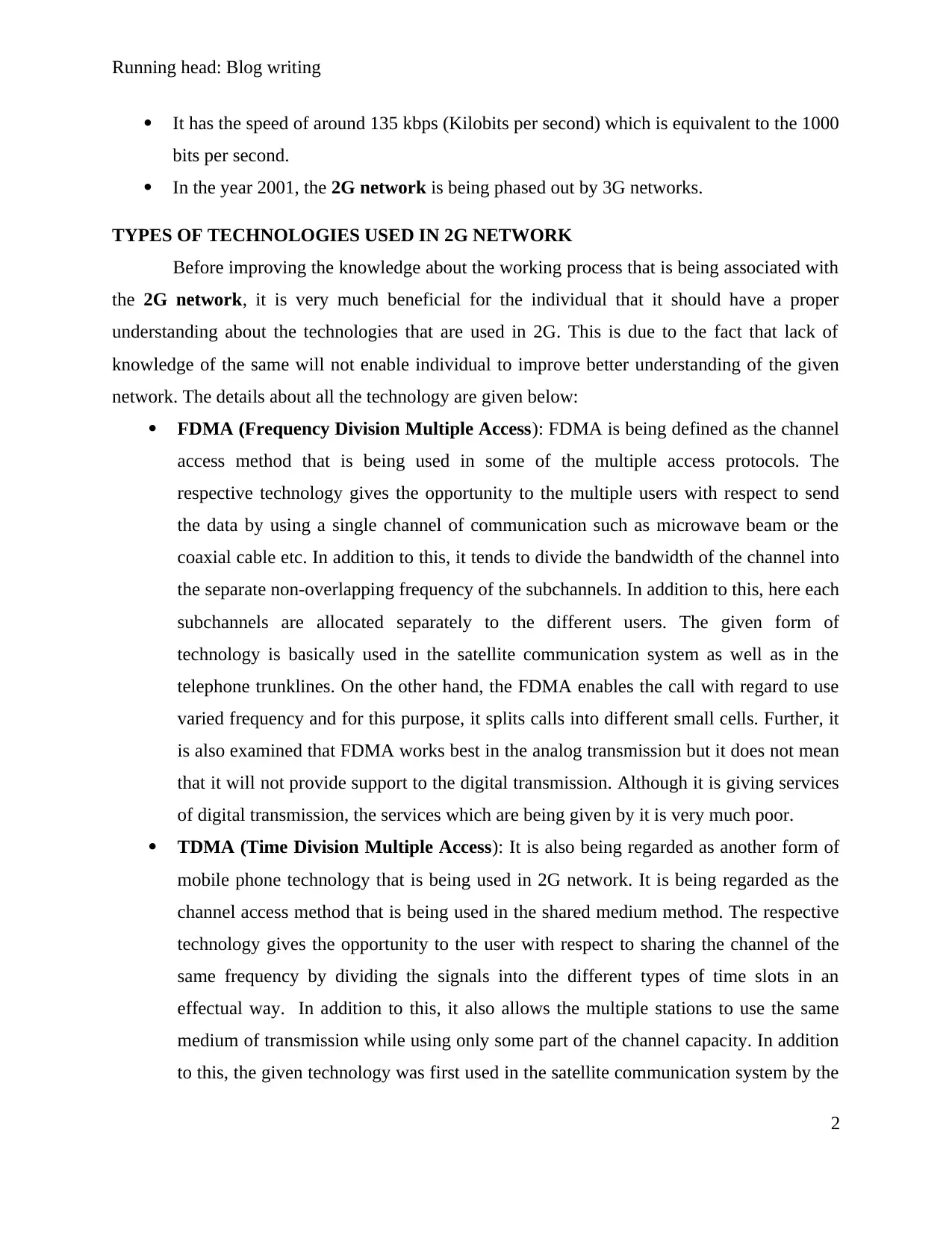
Running head: Blog writing
It has the speed of around 135 kbps (Kilobits per second) which is equivalent to the 1000
bits per second.
In the year 2001, the 2G network is being phased out by 3G networks.
TYPES OF TECHNOLOGIES USED IN 2G NETWORK
Before improving the knowledge about the working process that is being associated with
the 2G network, it is very much beneficial for the individual that it should have a proper
understanding about the technologies that are used in 2G. This is due to the fact that lack of
knowledge of the same will not enable individual to improve better understanding of the given
network. The details about all the technology are given below:
FDMA (Frequency Division Multiple Access): FDMA is being defined as the channel
access method that is being used in some of the multiple access protocols. The
respective technology gives the opportunity to the multiple users with respect to send
the data by using a single channel of communication such as microwave beam or the
coaxial cable etc. In addition to this, it tends to divide the bandwidth of the channel into
the separate non-overlapping frequency of the subchannels. In addition to this, here each
subchannels are allocated separately to the different users. The given form of
technology is basically used in the satellite communication system as well as in the
telephone trunklines. On the other hand, the FDMA enables the call with regard to use
varied frequency and for this purpose, it splits calls into different small cells. Further, it
is also examined that FDMA works best in the analog transmission but it does not mean
that it will not provide support to the digital transmission. Although it is giving services
of digital transmission, the services which are being given by it is very much poor.
TDMA (Time Division Multiple Access): It is also being regarded as another form of
mobile phone technology that is being used in 2G network. It is being regarded as the
channel access method that is being used in the shared medium method. The respective
technology gives the opportunity to the user with respect to sharing the channel of the
same frequency by dividing the signals into the different types of time slots in an
effectual way. In addition to this, it also allows the multiple stations to use the same
medium of transmission while using only some part of the channel capacity. In addition
to this, the given technology was first used in the satellite communication system by the
2
It has the speed of around 135 kbps (Kilobits per second) which is equivalent to the 1000
bits per second.
In the year 2001, the 2G network is being phased out by 3G networks.
TYPES OF TECHNOLOGIES USED IN 2G NETWORK
Before improving the knowledge about the working process that is being associated with
the 2G network, it is very much beneficial for the individual that it should have a proper
understanding about the technologies that are used in 2G. This is due to the fact that lack of
knowledge of the same will not enable individual to improve better understanding of the given
network. The details about all the technology are given below:
FDMA (Frequency Division Multiple Access): FDMA is being defined as the channel
access method that is being used in some of the multiple access protocols. The
respective technology gives the opportunity to the multiple users with respect to send
the data by using a single channel of communication such as microwave beam or the
coaxial cable etc. In addition to this, it tends to divide the bandwidth of the channel into
the separate non-overlapping frequency of the subchannels. In addition to this, here each
subchannels are allocated separately to the different users. The given form of
technology is basically used in the satellite communication system as well as in the
telephone trunklines. On the other hand, the FDMA enables the call with regard to use
varied frequency and for this purpose, it splits calls into different small cells. Further, it
is also examined that FDMA works best in the analog transmission but it does not mean
that it will not provide support to the digital transmission. Although it is giving services
of digital transmission, the services which are being given by it is very much poor.
TDMA (Time Division Multiple Access): It is also being regarded as another form of
mobile phone technology that is being used in 2G network. It is being regarded as the
channel access method that is being used in the shared medium method. The respective
technology gives the opportunity to the user with respect to sharing the channel of the
same frequency by dividing the signals into the different types of time slots in an
effectual way. In addition to this, it also allows the multiple stations to use the same
medium of transmission while using only some part of the channel capacity. In addition
to this, the given technology was first used in the satellite communication system by the
2
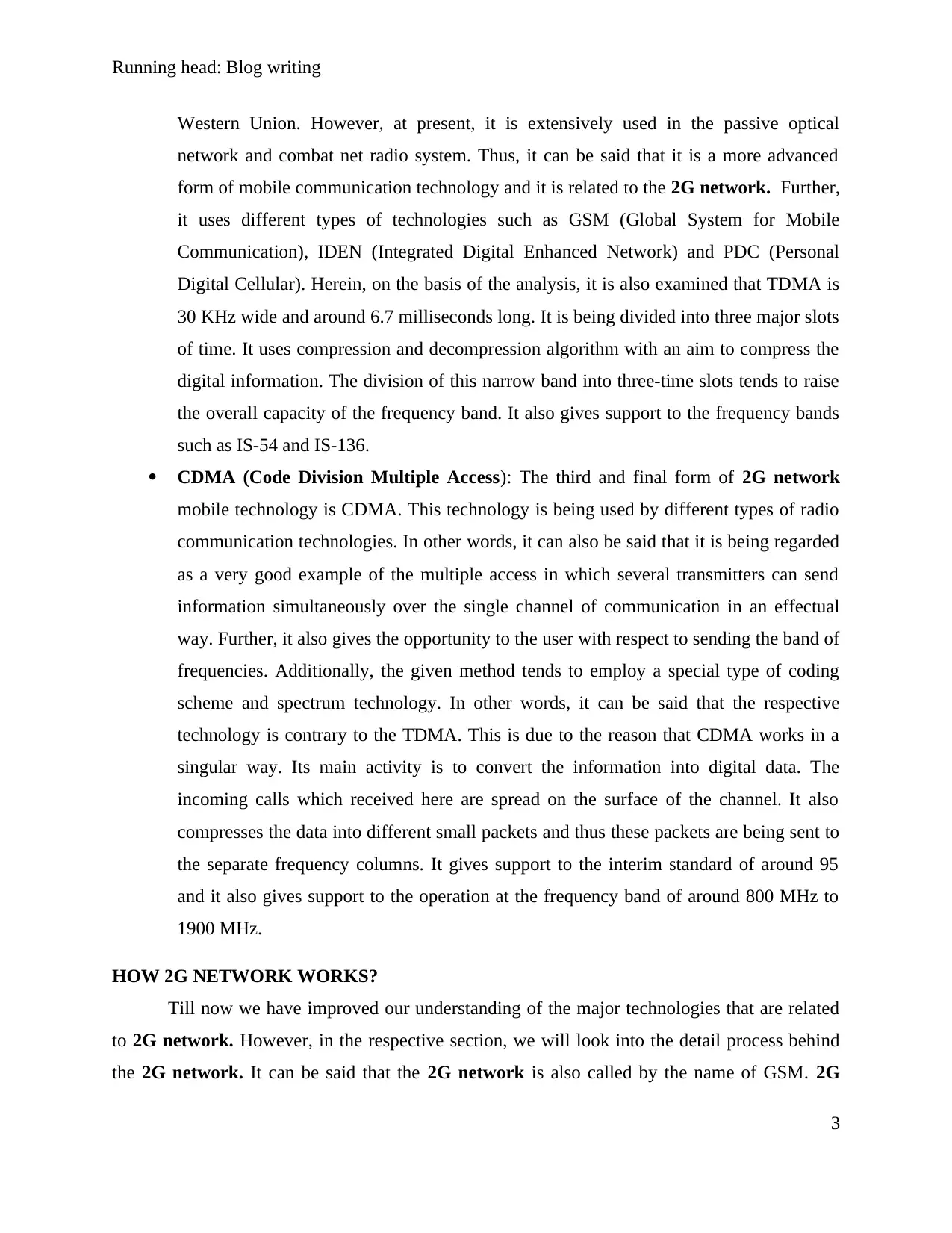
Running head: Blog writing
Western Union. However, at present, it is extensively used in the passive optical
network and combat net radio system. Thus, it can be said that it is a more advanced
form of mobile communication technology and it is related to the 2G network. Further,
it uses different types of technologies such as GSM (Global System for Mobile
Communication), IDEN (Integrated Digital Enhanced Network) and PDC (Personal
Digital Cellular). Herein, on the basis of the analysis, it is also examined that TDMA is
30 KHz wide and around 6.7 milliseconds long. It is being divided into three major slots
of time. It uses compression and decompression algorithm with an aim to compress the
digital information. The division of this narrow band into three-time slots tends to raise
the overall capacity of the frequency band. It also gives support to the frequency bands
such as IS-54 and IS-136.
CDMA (Code Division Multiple Access): The third and final form of 2G network
mobile technology is CDMA. This technology is being used by different types of radio
communication technologies. In other words, it can also be said that it is being regarded
as a very good example of the multiple access in which several transmitters can send
information simultaneously over the single channel of communication in an effectual
way. Further, it also gives the opportunity to the user with respect to sending the band of
frequencies. Additionally, the given method tends to employ a special type of coding
scheme and spectrum technology. In other words, it can be said that the respective
technology is contrary to the TDMA. This is due to the reason that CDMA works in a
singular way. Its main activity is to convert the information into digital data. The
incoming calls which received here are spread on the surface of the channel. It also
compresses the data into different small packets and thus these packets are being sent to
the separate frequency columns. It gives support to the interim standard of around 95
and it also gives support to the operation at the frequency band of around 800 MHz to
1900 MHz.
HOW 2G NETWORK WORKS?
Till now we have improved our understanding of the major technologies that are related
to 2G network. However, in the respective section, we will look into the detail process behind
the 2G network. It can be said that the 2G network is also called by the name of GSM. 2G
3
Western Union. However, at present, it is extensively used in the passive optical
network and combat net radio system. Thus, it can be said that it is a more advanced
form of mobile communication technology and it is related to the 2G network. Further,
it uses different types of technologies such as GSM (Global System for Mobile
Communication), IDEN (Integrated Digital Enhanced Network) and PDC (Personal
Digital Cellular). Herein, on the basis of the analysis, it is also examined that TDMA is
30 KHz wide and around 6.7 milliseconds long. It is being divided into three major slots
of time. It uses compression and decompression algorithm with an aim to compress the
digital information. The division of this narrow band into three-time slots tends to raise
the overall capacity of the frequency band. It also gives support to the frequency bands
such as IS-54 and IS-136.
CDMA (Code Division Multiple Access): The third and final form of 2G network
mobile technology is CDMA. This technology is being used by different types of radio
communication technologies. In other words, it can also be said that it is being regarded
as a very good example of the multiple access in which several transmitters can send
information simultaneously over the single channel of communication in an effectual
way. Further, it also gives the opportunity to the user with respect to sending the band of
frequencies. Additionally, the given method tends to employ a special type of coding
scheme and spectrum technology. In other words, it can be said that the respective
technology is contrary to the TDMA. This is due to the reason that CDMA works in a
singular way. Its main activity is to convert the information into digital data. The
incoming calls which received here are spread on the surface of the channel. It also
compresses the data into different small packets and thus these packets are being sent to
the separate frequency columns. It gives support to the interim standard of around 95
and it also gives support to the operation at the frequency band of around 800 MHz to
1900 MHz.
HOW 2G NETWORK WORKS?
Till now we have improved our understanding of the major technologies that are related
to 2G network. However, in the respective section, we will look into the detail process behind
the 2G network. It can be said that the 2G network is also called by the name of GSM. 2G
3
Secure Best Marks with AI Grader
Need help grading? Try our AI Grader for instant feedback on your assignments.
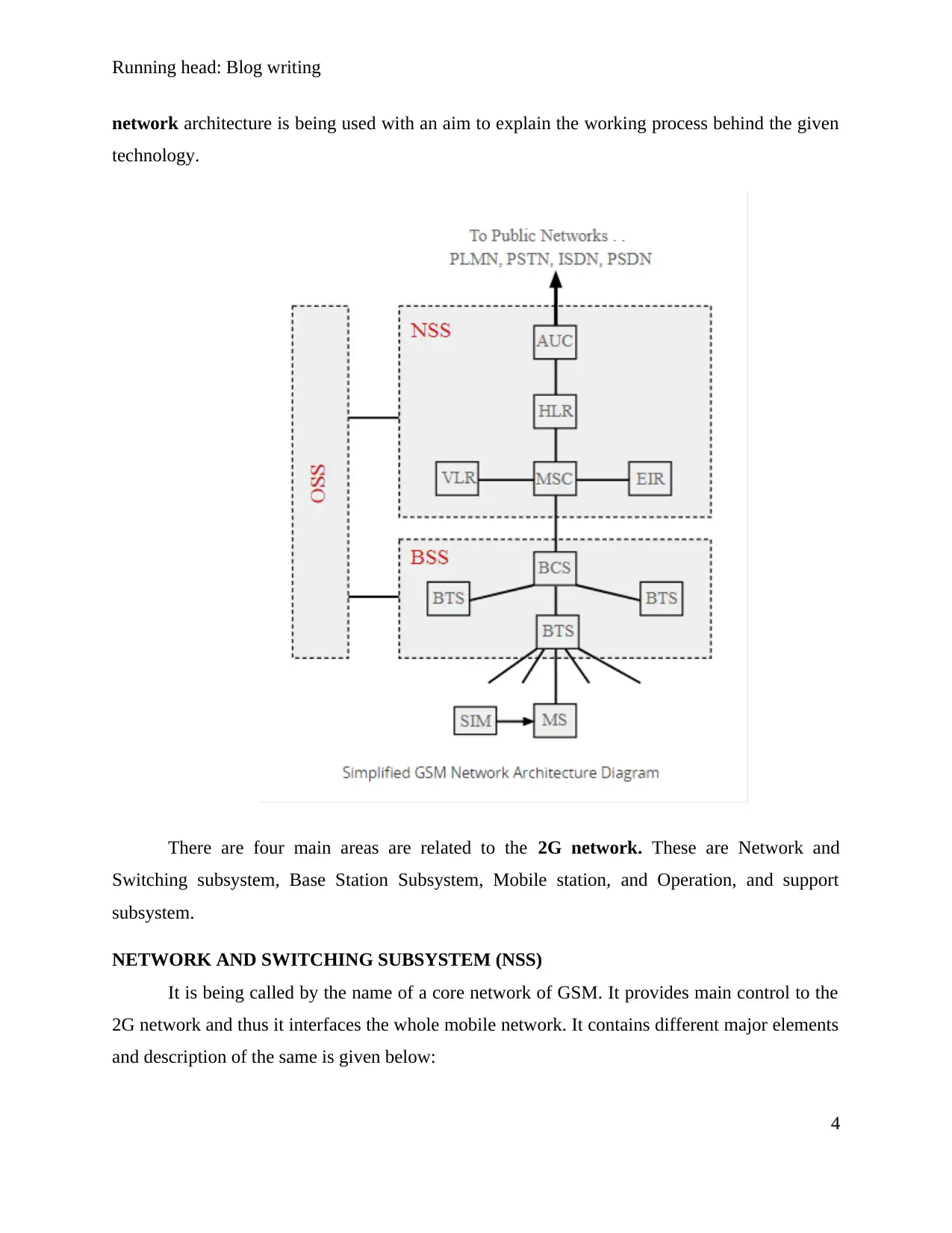
Running head: Blog writing
network architecture is being used with an aim to explain the working process behind the given
technology.
There are four main areas are related to the 2G network. These are Network and
Switching subsystem, Base Station Subsystem, Mobile station, and Operation, and support
subsystem.
NETWORK AND SWITCHING SUBSYSTEM (NSS)
It is being called by the name of a core network of GSM. It provides main control to the
2G network and thus it interfaces the whole mobile network. It contains different major elements
and description of the same is given below:
4
network architecture is being used with an aim to explain the working process behind the given
technology.
There are four main areas are related to the 2G network. These are Network and
Switching subsystem, Base Station Subsystem, Mobile station, and Operation, and support
subsystem.
NETWORK AND SWITCHING SUBSYSTEM (NSS)
It is being called by the name of a core network of GSM. It provides main control to the
2G network and thus it interfaces the whole mobile network. It contains different major elements
and description of the same is given below:
4
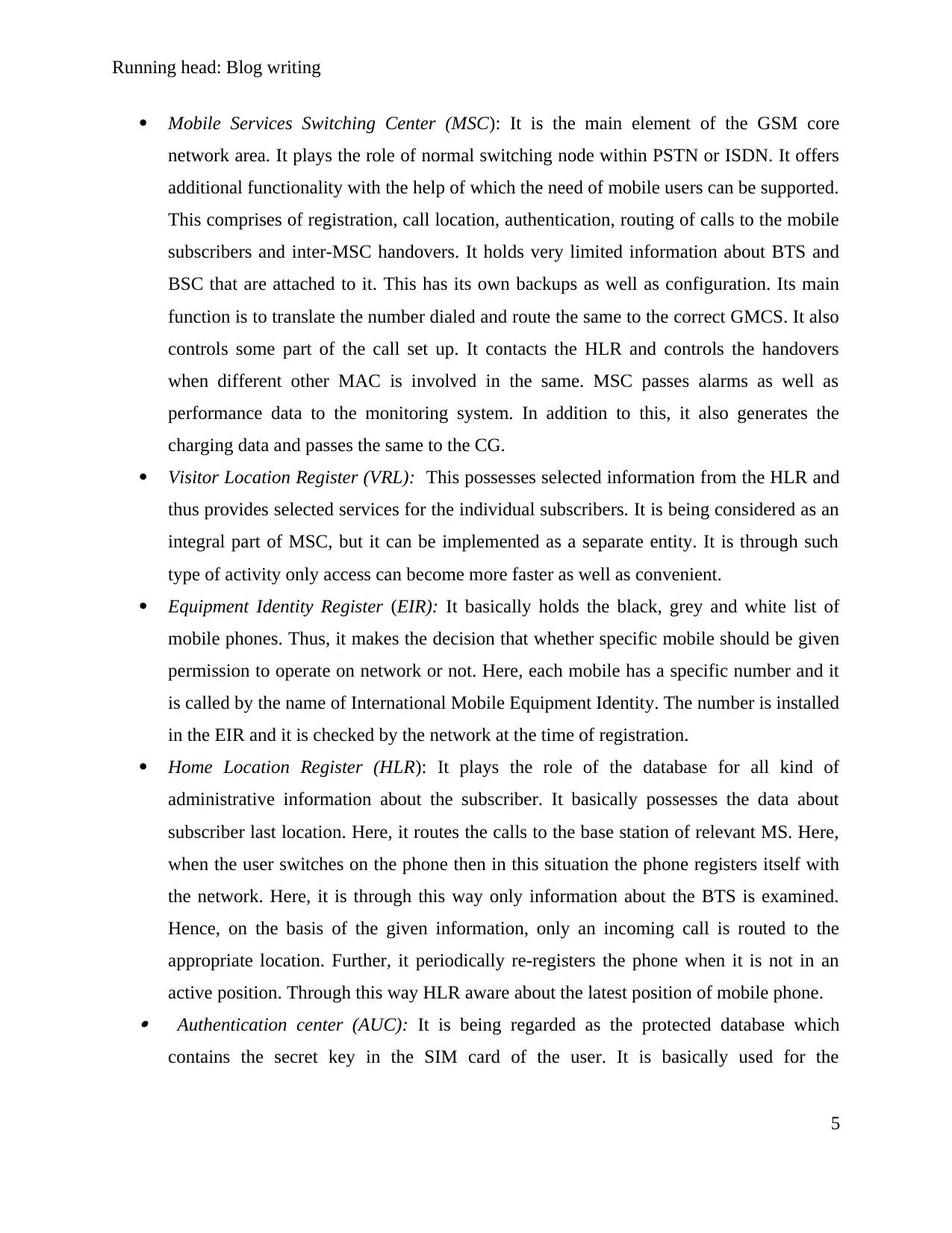
Running head: Blog writing
Mobile Services Switching Center (MSC): It is the main element of the GSM core
network area. It plays the role of normal switching node within PSTN or ISDN. It offers
additional functionality with the help of which the need of mobile users can be supported.
This comprises of registration, call location, authentication, routing of calls to the mobile
subscribers and inter-MSC handovers. It holds very limited information about BTS and
BSC that are attached to it. This has its own backups as well as configuration. Its main
function is to translate the number dialed and route the same to the correct GMCS. It also
controls some part of the call set up. It contacts the HLR and controls the handovers
when different other MAC is involved in the same. MSC passes alarms as well as
performance data to the monitoring system. In addition to this, it also generates the
charging data and passes the same to the CG.
Visitor Location Register (VRL): This possesses selected information from the HLR and
thus provides selected services for the individual subscribers. It is being considered as an
integral part of MSC, but it can be implemented as a separate entity. It is through such
type of activity only access can become more faster as well as convenient.
Equipment Identity Register (EIR): It basically holds the black, grey and white list of
mobile phones. Thus, it makes the decision that whether specific mobile should be given
permission to operate on network or not. Here, each mobile has a specific number and it
is called by the name of International Mobile Equipment Identity. The number is installed
in the EIR and it is checked by the network at the time of registration.
Home Location Register (HLR): It plays the role of the database for all kind of
administrative information about the subscriber. It basically possesses the data about
subscriber last location. Here, it routes the calls to the base station of relevant MS. Here,
when the user switches on the phone then in this situation the phone registers itself with
the network. Here, it is through this way only information about the BTS is examined.
Hence, on the basis of the given information, only an incoming call is routed to the
appropriate location. Further, it periodically re-registers the phone when it is not in an
active position. Through this way HLR aware about the latest position of mobile phone. Authentication center (AUC): It is being regarded as the protected database which
contains the secret key in the SIM card of the user. It is basically used for the
5
Mobile Services Switching Center (MSC): It is the main element of the GSM core
network area. It plays the role of normal switching node within PSTN or ISDN. It offers
additional functionality with the help of which the need of mobile users can be supported.
This comprises of registration, call location, authentication, routing of calls to the mobile
subscribers and inter-MSC handovers. It holds very limited information about BTS and
BSC that are attached to it. This has its own backups as well as configuration. Its main
function is to translate the number dialed and route the same to the correct GMCS. It also
controls some part of the call set up. It contacts the HLR and controls the handovers
when different other MAC is involved in the same. MSC passes alarms as well as
performance data to the monitoring system. In addition to this, it also generates the
charging data and passes the same to the CG.
Visitor Location Register (VRL): This possesses selected information from the HLR and
thus provides selected services for the individual subscribers. It is being considered as an
integral part of MSC, but it can be implemented as a separate entity. It is through such
type of activity only access can become more faster as well as convenient.
Equipment Identity Register (EIR): It basically holds the black, grey and white list of
mobile phones. Thus, it makes the decision that whether specific mobile should be given
permission to operate on network or not. Here, each mobile has a specific number and it
is called by the name of International Mobile Equipment Identity. The number is installed
in the EIR and it is checked by the network at the time of registration.
Home Location Register (HLR): It plays the role of the database for all kind of
administrative information about the subscriber. It basically possesses the data about
subscriber last location. Here, it routes the calls to the base station of relevant MS. Here,
when the user switches on the phone then in this situation the phone registers itself with
the network. Here, it is through this way only information about the BTS is examined.
Hence, on the basis of the given information, only an incoming call is routed to the
appropriate location. Further, it periodically re-registers the phone when it is not in an
active position. Through this way HLR aware about the latest position of mobile phone. Authentication center (AUC): It is being regarded as the protected database which
contains the secret key in the SIM card of the user. It is basically used for the
5
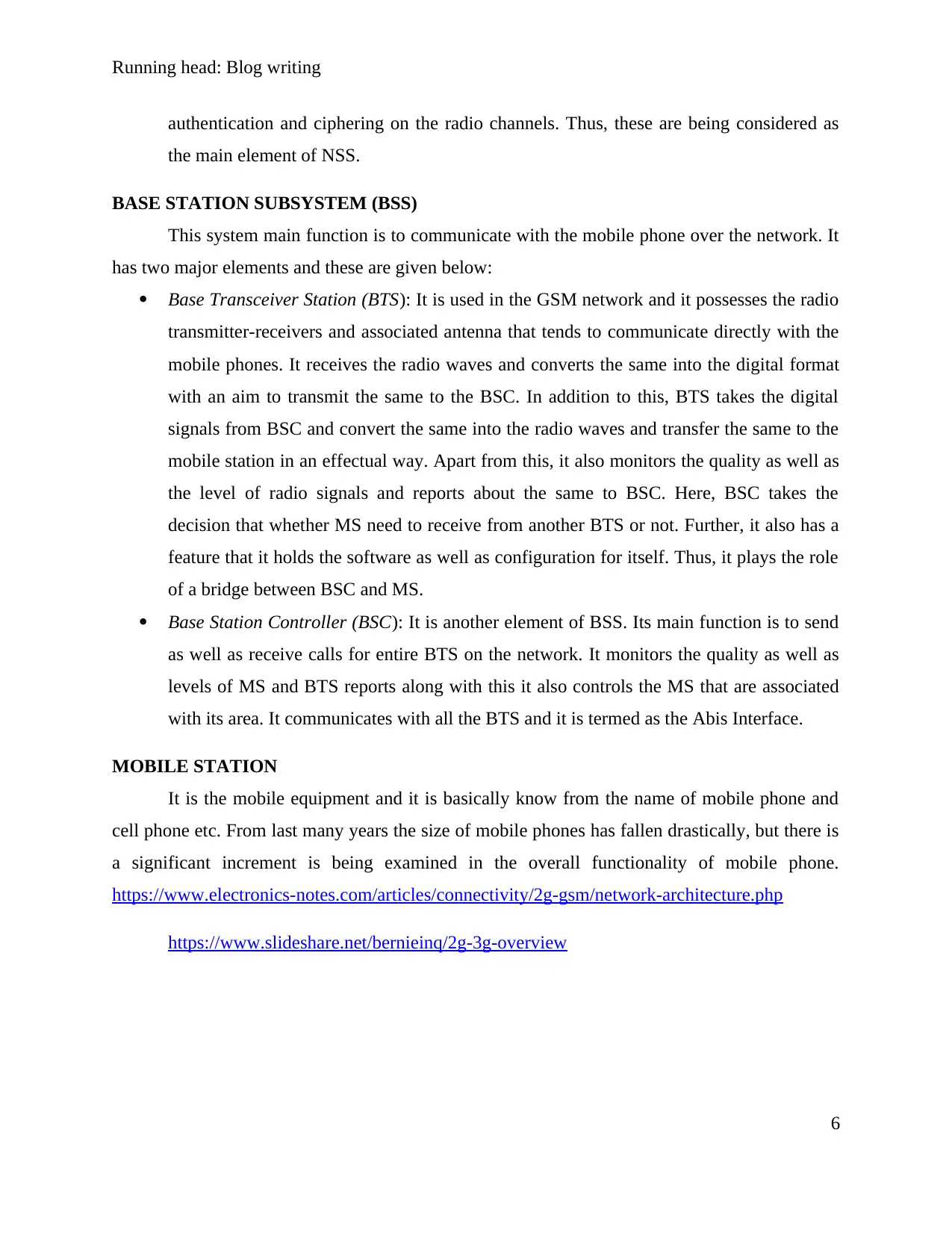
Running head: Blog writing
authentication and ciphering on the radio channels. Thus, these are being considered as
the main element of NSS.
BASE STATION SUBSYSTEM (BSS)
This system main function is to communicate with the mobile phone over the network. It
has two major elements and these are given below:
Base Transceiver Station (BTS): It is used in the GSM network and it possesses the radio
transmitter-receivers and associated antenna that tends to communicate directly with the
mobile phones. It receives the radio waves and converts the same into the digital format
with an aim to transmit the same to the BSC. In addition to this, BTS takes the digital
signals from BSC and convert the same into the radio waves and transfer the same to the
mobile station in an effectual way. Apart from this, it also monitors the quality as well as
the level of radio signals and reports about the same to BSC. Here, BSC takes the
decision that whether MS need to receive from another BTS or not. Further, it also has a
feature that it holds the software as well as configuration for itself. Thus, it plays the role
of a bridge between BSC and MS.
Base Station Controller (BSC): It is another element of BSS. Its main function is to send
as well as receive calls for entire BTS on the network. It monitors the quality as well as
levels of MS and BTS reports along with this it also controls the MS that are associated
with its area. It communicates with all the BTS and it is termed as the Abis Interface.
MOBILE STATION
It is the mobile equipment and it is basically know from the name of mobile phone and
cell phone etc. From last many years the size of mobile phones has fallen drastically, but there is
a significant increment is being examined in the overall functionality of mobile phone.
https://www.electronics-notes.com/articles/connectivity/2g-gsm/network-architecture.php
https://www.slideshare.net/bernieinq/2g-3g-overview
6
authentication and ciphering on the radio channels. Thus, these are being considered as
the main element of NSS.
BASE STATION SUBSYSTEM (BSS)
This system main function is to communicate with the mobile phone over the network. It
has two major elements and these are given below:
Base Transceiver Station (BTS): It is used in the GSM network and it possesses the radio
transmitter-receivers and associated antenna that tends to communicate directly with the
mobile phones. It receives the radio waves and converts the same into the digital format
with an aim to transmit the same to the BSC. In addition to this, BTS takes the digital
signals from BSC and convert the same into the radio waves and transfer the same to the
mobile station in an effectual way. Apart from this, it also monitors the quality as well as
the level of radio signals and reports about the same to BSC. Here, BSC takes the
decision that whether MS need to receive from another BTS or not. Further, it also has a
feature that it holds the software as well as configuration for itself. Thus, it plays the role
of a bridge between BSC and MS.
Base Station Controller (BSC): It is another element of BSS. Its main function is to send
as well as receive calls for entire BTS on the network. It monitors the quality as well as
levels of MS and BTS reports along with this it also controls the MS that are associated
with its area. It communicates with all the BTS and it is termed as the Abis Interface.
MOBILE STATION
It is the mobile equipment and it is basically know from the name of mobile phone and
cell phone etc. From last many years the size of mobile phones has fallen drastically, but there is
a significant increment is being examined in the overall functionality of mobile phone.
https://www.electronics-notes.com/articles/connectivity/2g-gsm/network-architecture.php
https://www.slideshare.net/bernieinq/2g-3g-overview
6
1 out of 7
Related Documents
Your All-in-One AI-Powered Toolkit for Academic Success.
+13062052269
info@desklib.com
Available 24*7 on WhatsApp / Email
![[object Object]](/_next/static/media/star-bottom.7253800d.svg)
Unlock your academic potential
© 2024 | Zucol Services PVT LTD | All rights reserved.





